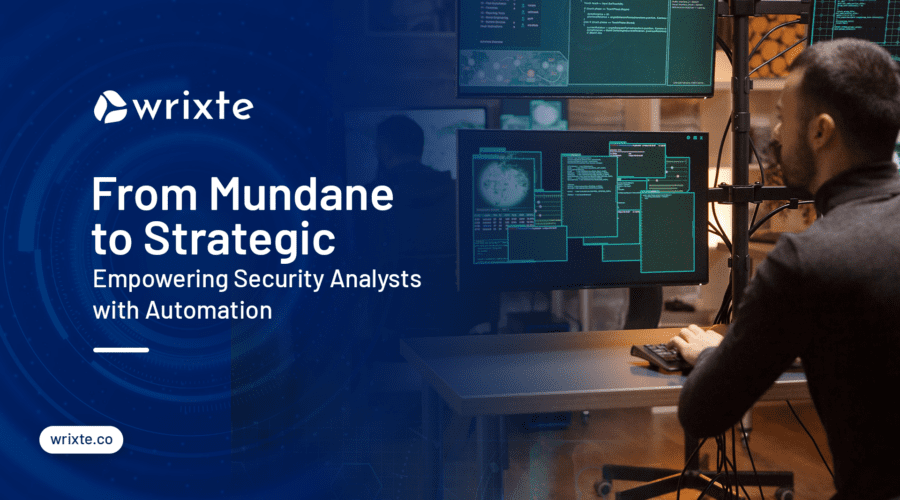We are all quite aware of the fact that cybersecurity has become a top priority for organizations of all sizes, as cyber threats continue to evolve in sophistication and frequency. As a result, security analysts face a daunting task of safeguarding sensitive data and networks from an ever-expanding array of threats. Traditional manual approaches to cybersecurity are no longer sufficient to defend against these relentless attacks. This is where the power of cybersecurity automation comes into play.
Cybersecurity automation represents a transformative shift in the way security analysts operate. By harnessing cutting-edge technologies such as machine learning, artificial intelligence, and advanced orchestration, automation empowers security analysts to proactively detect, respond, and mitigate threats in real-time, leading to more efficient and effective defense mechanisms.
In this blog, Wrixte will explore the pivotal role of cybersecurity automation and how it empowers security analysts to transcend manual processes. We will delve into various technical aspects of automation, including its integration with existing infrastructure, the rise of AI and ML-driven defense mechanisms, and the future trends that promise to shape the landscape of cybersecurity automation.
The Evolution of Security Analysts’ Roles
Traditionally, security analysts spent a significant portion of their time on tedious tasks like log analysis, vulnerability scanning, and incident ticketing. Automation has revolutionized this landscape, allowing analysts to transition from reactive, manual roles to proactive defenders.
Automation streamlines and accelerates incident detection, response, and recovery, enabling analysts to concentrate on threat hunting, threat intelligence analysis, and strategic decision-making. However, this evolution demands security analysts to acquire new skills and knowledge in handling automation tools and understanding the intricacies of automated threat detection mechanisms.
Types of Cybersecurity Automation
Automated Threat Detection and Response: Intrusion Detection Systems (IDS) and Security Information and Event Management (SIEM) solutions leverage automation to analyze vast amounts of data in real-time, identifying potential threats and triggering automated response actions.
Automated Vulnerability Scanning: Network vulnerability scanners and application security testing tools automatically detect vulnerabilities in networks and applications, expediting the remediation process.
Automated Incident Response: Incident response playbooks and runbooks automate the step-by-step response to various cyber incidents, ensuring consistency and reducing response time.
Technical Components of Cybersecurity Automation
Machine Learning and Artificial Intelligence in Cybersecurity: Machine learning algorithms aid in identifying patterns and anomalies, improving threat detection accuracy and reducing false positives. Artificial intelligence enhances automation capabilities through predictive analytics and intelligent decision-making.
Integration of Automation Tools with Existing Infrastructure: Effective automation requires seamless integration with the organization’s existing security infrastructure. APIs and custom workflows facilitate smooth interactions between different security tools and systems.
Human-in-the-Loop Automation: While automation streamlines processes, human oversight remains critical for critical decision-making and handling complex incidents. Human analysts are responsible for supervising automated processes, ensuring appropriate responses, and refining automation workflows.
Advantages of Automation for Security Analysts:
Automation offers security analysts several advantages, streamlining their workflows and enhancing overall efficiency. By automating routine and repetitive tasks such as log analysis and incident ticketing, analysts can focus on critical activities like threat hunting and strategic decision-making. Automated threat detection and response mechanisms enable faster identification and mitigation of cyber threats, reducing the response time to potential incidents.
Moreover, machine learning and AI-driven algorithms enhance accuracy in threat detection, minimizing false positives and negatives. Ultimately, automation empowers security analysts to optimize their efforts, stay ahead of evolving threats, and strengthen an organization’s cybersecurity posture.
Future Trends in Cybersecurity Automation
Quantum Computing in Cybersecurity Automation: Quantum-resistant cryptographic algorithms are being developed to secure data and communications against potential quantum threats. Additionally, the immense processing power of quantum computers can enable faster analysis of vast amounts of data, making threat detection and response even more efficient.
Autonomics and Self-Healing Systems: Autonomics refers to the ability of systems to perform tasks without human intervention by leveraging artificial intelligence, machine learning, and advanced analytics. In the context of cybersecurity, autonomics can lead to self-healing systems that automatically detect and respond to threats in real-time. These self-healing systems can proactively identify and remediate vulnerabilities, neutralize attacks, and restore systems to their secure state without manual intervention.
Hyper-Automation and Robotic Process Automation (RPA): Hyper-automation goes beyond traditional automation by combining multiple automation technologies, including AI, machine learning, and RPA. In the context of cybersecurity, hyper-automation can optimize incident response by automatically identifying, investigating, and remediating security incidents across different systems and applications.
Cyber-Physical Systems (CPS) Security Automation: As the world becomes increasingly interconnected through the Internet of Things (IoT) and Industrial Internet of Things (IIoT), securing cyber-physical systems becomes crucial. CPS security automation involves integrating cybersecurity measures into connected devices and industrial control systems.
Conclusion
Cybersecurity automation empowers security analysts to evolve from reactive to proactive defenders. By leveraging cutting-edge technologies like AI, machine learning, and advanced orchestration, automation streamlines incident detection, response, and recovery processes. Analysts can focus on strategic decision-making and threat hunting as routine tasks get automated.
Automated threat detection and response reduce cyber threat response time and improve overall efficiency. The integration of AI and machine learning enhances accuracy, minimizing false positives and negatives.
Looking to the future, quantum computing, autonomics, hyper-automation, and CPS security automation will drive further advancements. Organizations embracing these trends can stay ahead of evolving threats and ensure robust cybersecurity.
Take charge of your cybersecurity with Wrixte! Partner with us and leverage automation to safeguard your organization from evolving threats.
